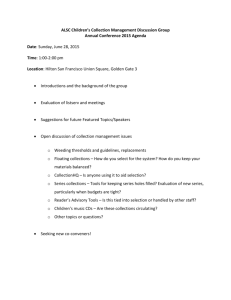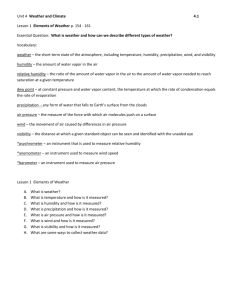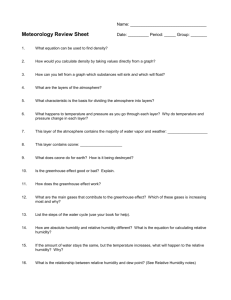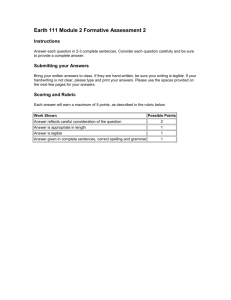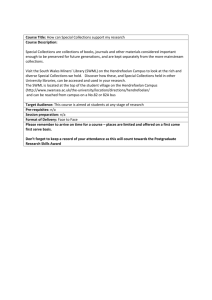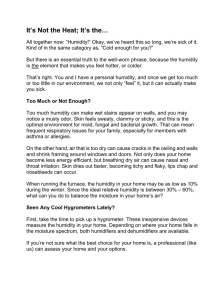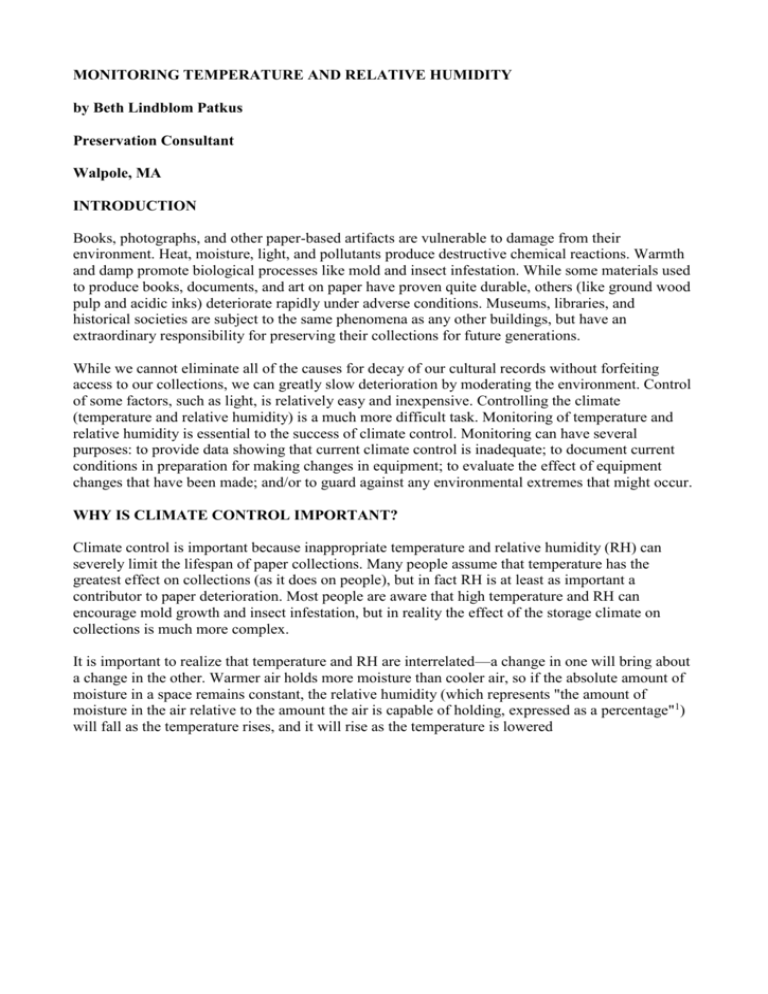
MONITORING TEMPERATURE AND RELATIVE HUMIDITY
by Beth Lindblom Patkus
Preservation Consultant
Walpole, MA
INTRODUCTION
Books, photographs, and other paper-based artifacts are vulnerable to damage from their
environment. Heat, moisture, light, and pollutants produce destructive chemical reactions. Warmth
and damp promote biological processes like mold and insect infestation. While some materials used
to produce books, documents, and art on paper have proven quite durable, others (like ground wood
pulp and acidic inks) deteriorate rapidly under adverse conditions. Museums, libraries, and
historical societies are subject to the same phenomena as any other buildings, but have an
extraordinary responsibility for preserving their collections for future generations.
While we cannot eliminate all of the causes for decay of our cultural records without forfeiting
access to our collections, we can greatly slow deterioration by moderating the environment. Control
of some factors, such as light, is relatively easy and inexpensive. Controlling the climate
(temperature and relative humidity) is a much more difficult task. Monitoring of temperature and
relative humidity is essential to the success of climate control. Monitoring can have several
purposes: to provide data showing that current climate control is inadequate; to document current
conditions in preparation for making changes in equipment; to evaluate the effect of equipment
changes that have been made; and/or to guard against any environmental extremes that might occur.
WHY IS CLIMATE CONTROL IMPORTANT?
Climate control is important because inappropriate temperature and relative humidity (RH) can
severely limit the lifespan of paper collections. Many people assume that temperature has the
greatest effect on collections (as it does on people), but in fact RH is at least as important a
contributor to paper deterioration. Most people are aware that high temperature and RH can
encourage mold growth and insect infestation, but in reality the effect of the storage climate on
collections is much more complex.
It is important to realize that temperature and RH are interrelated—a change in one will bring about
a change in the other. Warmer air holds more moisture than cooler air, so if the absolute amount of
moisture in a space remains constant, the relative humidity (which represents "the amount of
moisture in the air relative to the amount the air is capable of holding, expressed as a percentage"1)
will fall as the temperature rises, and it will rise as the temperature is lowered
(these relationships between temperature and RH can be calculated using a psychometric chart). For
example, if a space is at 60° F and 70% RH, the RH will fall to about 40% if the temperature is
raised to 75° F. On the other hand, if the temperature is lowered the RH will rise—and when it
reaches 100% the air will become saturated and moisture will condense out (this is called the
dewpoint). For example, if a space is at 70° F and 50% RH and the temperature suddenly drops to
below 50° F, condensation will occur on collections.
Embrittlement of paper (along with many other forms of decay in such organic materials as leather,
textiles, and magnetic tape) is an indication of chemical deterioration, and the chemical reactions
that govern this process are greatly influenced by the climate. Temperature increases the speed of
the chemical reactions that cause acidic deterioration. A familiar rule of thumb estimates that
chemical reactions double with each 18°F (10°C) increase. In the special case of cellulose, artificial
aging tests indicate that each 9°F increase nearly doubles the rate of deterioration, even in the
absence of light, pollutants, or other factors. Relative humidity provides moisture to fuel these
reactions—the higher the humidity, the more quickly deterioration proceeds.
Research models have been developed in the last several years that quantify the effects of
temperature and relative humidity on chemical deterioration. The Image Permanence Institute (IPI)
at the Rochester Institute of Technology has developed the "Preservation Index," which builds on
work done by Donald Sebera, formerly of the Library of Congress. This tool gives a general idea of
the length of time it would take paper collections to become noticeably deteriorated at a particular
temperature and RH. The model shows that short-lived organic materials stored at 72° F and 50%
RH would have an approximate lifetime of 33 years, but if the temperature were lowered to 62° F
and the humidity to 40%, such materials would have a lifetime of 88 years. The model also shows
that if materials are subjected to high temperatures and humidities (such as 82° F and 75% RH)
noticeable deterioration would occur in 9 years or less.2
Another interesting aspect of this research is that it demonstrates that the same projected lifespan
can be achieved through different combinations of temperature and RH. For example, conditions of
57° F and 50% RH or 62° F and 35%RH would both result in a predicted lifetime of close to 100
years.3 This has the potential to offer institutions some flexibility in how they control the climate,
although extremely high humidities or temperatures must always be avoided due to the danger of
mold and insect infestation.
The effects of fluctuations in temperature and RH on collections is another important concern for
climate control. Fluctuations in temperature are serious—research done at the Library of Congress
has shown that chemical deterioration of paper proceeds more quickly if paper is exposed to
temperature fluctuations than if it is stored at a constant temperature. In addition, paper—like many
other materials—is hygroscopic, meaning it absorbs and gives off moisture. This means that as the
temperature rises and the RH decreases, moisture will migrate from a hygroscopic object to the air
as the object tries to maintain equilibrium. As the temperature drops and the RH rises again,
moisture will move back into the object. This process can cause physical stress as the changing
moisture content causes the material to swell and shrink. It can result in serious damage to
composite materials such as furniture and art works, and it can cause cockling and distortion in
books and paper (although in some situations books and paper collections are protected from
moderate RH fluctuations because RH changes are buffered by storage enclosures or by books
being packed closely together4).
Finally, collections managers must be aware that while there is no danger associated with low
temperature storage (in fact such storage greatly slows deterioration), very low RH can be
damaging to some materials. Traditionally there has been concern about paper becoming too brittle
to be handled at very low humidities. Research has shown that paper can be safely handled at
around 20% RH—or 30% if it is to be folded—so there is no need to store it at
40-50% RH for the purposes of handling. For parchment and photographic materials, lower
humidities are being recommended for chemical stability—but these materials should not be stored
below 30% RH. Especially in the case of parchment, it is also important not to change the climate
rapidly, since this might cause damage.5
It seems clear that a significant investment in the acquisition of information, aesthetic artifacts, and
cultural records for research, exhibit, and education warrants active protection of the acquired
materials. It should be equally clear that the climate of a storage environment will profoundly affect
the condition of these objects.
CLIMATE CONTROL IS EXPENSIVE - WHAT IS GOOD ENOUGH?
Although the preservation community has been unable to agree on specific standards for climate
control in paper-based collections, authorities do agree on several general conclusions that emanate
from research:
• Temperatures above about 70°F and RH above about 55-60% encourage mold and insects.
• Additional damage occurs at climatic extremes: high RH increases acid formation; RH below 30%
can embrittle paper, parchment, adhesives, photographic emulsions, and other materials.
• Within these limits, the lower the temperature and RH can be kept, the better—provided they do
not fluctuate.6
As a first step towards limiting deterioration by good climate control, an institution should aim at
maintaining stable conditions year round, no higher than 70°F and between 30-50% RH. These are
the suggested values given in Environmental Guidelines for the Storage of Paper-Records, a
technical report issued by the National Information Standards Organization. This report is not a
standard, but it offers useful guidelines for climate control. The report specifies that one target value
within the range of 30-50% should be chosen for relative humidity, depending on what the
institution's climate control system can maintain consistently. The report notes that temperature
should not vary more than ± 2°F and RH should not vary more than ±3% in any 24-hour period. If
fluctuations can be controlled, damage to collections will be significantly slower than it has been
under the typical range of storage conditions in many areas of the United States and Canada.
Institutions committed to long-term preservation must be willing to budget for the best achievable
climate. At least, where winter-long heating is necessary, temperatures should be kept as low as
staff can be persuaded to tolerate (assuming the resulting RH is acceptable). Where summer
temperature and RH are high, collections of lasting importance should be air conditioned.
In no case should climate-control equipment be turned off or thermostat settings altered over night,
during weekends, or in other periods when the facility is unoccupied. The rapid, repeated changes
that result when equipment attempts to bring a building from "closed" conditions to "working"
conditions produce significant stress on collections. In some areas, severe weather or economics
force institutions to close for the winter. In such situations, it is not cold that is a preservation
hazard, but potentially unstable humidity in a building that is inadequately insulated or poorly
sealed to prevent air migration. Procedures for winterizing collections have been developed. In
addition, it appears that control of winter humidity by low levels of heat in conjunction with
humidity sensors may be practical.
If winters are severe, central heating can dramatically lower the RH of a building. Where a
humidification system is feasible, it should be steam-based, and the source of the steam should be
clean and independent of other systems. Most steam and hot water heating systems use anticorrosive chemicals to prevent damage to pipes. These chemicals can harm staff and collections if
they are injected into the air.
Under prolonged high humidity, conventional air conditioning alone usually will not provide
adequate dehumidification. Environments that are air conditioned should therefore be carefully
monitored. Chemical desiccants can put damaging abrasives into the air and should be used only in
emergencies. Additional refrigeration cooling is preferable.
Maintaining perfect conditions is difficult and expensive, particularly in northern climates subject to
both hot, humid summers and cold, dry winters. The NISO guidelines include specifications for
allowing the temperature and relative humidity to drift (change gradually in one direction) 3°F or
3% RH each month, following the changes of the seasons. The maximum allowable daily
fluctuation would be ±2°F and ±3% RH. Careful monitoring is necessary to track such changes
accurately.
HOW CAN YOU TELL IF THE CLIMATE IS OK?
The only way to know what climate exists in your building is to measure and record temperature
and RH with instruments designed for that purpose. This should be done systematically wherever
collections of permanent value are stored. A concrete, accurate record can move climate control out
of the hypothetical realm into a set of practical steps or goals for improving storage or exhibit
conditions. It is often helpful in convincing senior decision-makers that concerns about a building's
climate are not imaginary.
In addition to documenting existing conditions, a monitoring program can guide and record the
effect of changes in the operation of available climate control equipment. Heating, ventilation, and
air conditioning (HVAC) systems are seldom optimally used, even when all the components are in
place. A building maintenance engineer or the contractor responsible for the HVAC system can
often improve its performance, if concrete information is available to show the effect of altered
thermostats, filter replacement, or even rearranging furniture to unblock vents.
If climate-control equipment was designed to produce the desired conditions, but problems cannot
be solved by simple adjustments and routine maintenance, it may be necessary to have the system
professionally rebalanced. Balancing is a process that measures air flow and other characteristics of
HVAC systems; it requires the expertise of a professional climate-control engineer.
If conditions cannot be improved with existing equipment, a monitoring program can document the
severity of the problem and support the need to add machinery. Under the best circumstances, it will
indicate that available climate-control equipment is operating properly and handling the
environmental load. It may also identify occasional transient problems.
HOW DO YOU MONITOR CLIMATE?
There are various instruments available to measure temperature and RH. They fall into two
categories: those that provide "snapshot" measurements (i.e., a record of conditions at a specific
moment) and those that provide a continuous record of climate conditions. Each institution must
analyze its own needs and resources to determine which monitoring instrument is most appropriate.
The most common instruments are described below.7
"Snapshot" monitoring devices:
1. Thermometers can provide accurate temperature information for about $10.00. Calibrated
thermometers for scientific use are available, but at this level of accuracy, a standard thermometer
that measures the entire range of foreseeable conditions in your building is satisfactory. Most
instruments that measure RH incorporate a temperature sensor of some sort, since RH is a function
of air temperature and the amount of moisture available in the air.
2. Simple dial-type hygrometers, available from most hardware stores for $15.00 or less, are an
inexpensive way to measure RH, but they are not recommended because they can be inaccurate and
most cannot be recalibrated. The only exception are "animal membrane" dial hygrometers, which
are more accurate.
3. Humidity indicator strips or color cards are another inexpensive (from $1.00 -$5.00 per strip)
humidity-monitoring device. Some are reversible and thus can be reused, while others are for onetime use. Humidity indicator strips provide only approximate readings; they have been shown to be
reliable for indicating extremely high or low conditions.
4. Sling psychrometers (about $100) are the least expensive instrument capable of accurate RH
measurements. Two thermometers are mounted side by side. The bulb of one is covered with a
wick, which the user wets with distilled water. The instrument is swung, rotating about once per
second for several minutes to get an accurate reading. The resulting flow of air over the wet wick
cools the second thermometer, and the difference between the dry bulb and wet bulb temperatures is
used to calculate the RH.
While conditions can be recorded using a sling psychrometer (preferably several times per day),
accuracy depends on the design of the instrument and the skill of the user. The people responsible
for monitoring need to practice until readings are reproducible.
The major advantages of a sling psychrometer are cost and portability. One instrument can be used
in many spaces each day. Disadvantages are inaccuracy in the hands of an inexpert user, problems
with reproducible measurements, and the fact that a monitoring program based on spot readings will
not provide critical information such as the speed and frequency of variations in each 24-hour
period. These instruments provide only a rough picture of the environment, dependent on a human
monitor who may not be around to record information at midnight, or over holidays and weekends,
when conditions will often reach extremes. For useful comparison, measurements need to be made
at the same times and the same locations each day.
5. Battery-operated (motor-blower) psychrometers work on the same principle as a sling
psychrometer, but use a motor-driven fan to generate the air flow. These are moderately priced
(about $150 and up), are less prone to error, and can be conveniently moved to monitor a wide
variety of spaces. They too are likely to fail to measure the most extreme conditions and rapid
changes in the environment, since they depend on a human user. Replacement batteries should
always be on hand.
6. An electronic temperature/humidity meter is another hand-held instrument that uses a
calibrated sensor to measure RH at a known temperature. Many have liquid crystal displays that
give both RH and room temperature. These range from about $300 and up, and also depend on the
time and frequency of measurements. While they are capable of great accuracy and are easy to use,
some of the more inexpensive models may be accurate only to ±3-5% and may take several minutes
to react to changes in RH. These instruments need to be recalibrated periodically as recommended
by the manufacturer.
7. Min/max digital thermohygrometers are battery-operated instruments that combine
temperature and RH sensors with a computer chip that retains a memory of minimum and
maximum values until it is manually reset. Like other spot measurement tools, these provide
information about conditions at only one moment in time, but they do insure a record of highest and
lowest conditions in each interval. A human monitor must record the measurements and reset the
meter once a day. Humidity measurements tend to be accurate only to about ±5% (at mid-range
temperatures—accuracy may be less at temperature extremes), but these instruments can provide an
initial broad outline of climate conditions. These are available at below $70.00 through several
vendors.
Continuous monitoring devices:
1. A recording hygrothermograph has been the standard choice for monitoring temperature and
RH. Features to look for include:
• The hygrothermograph should use a human hair bundle to measure RH and a bimetallic device to
measure temperature.
• The sensors will be attached to pens that record changes continually on a simple graph—these
pens should be an easily replaceable cartridge type.
• The minimum acceptable variation in accuracy for temperature is ±2°F; minimum RH is ±5%
(±3% is preferred). Make sure the instrument will work in the most extreme conditions your
building experiences.
• Hygrothermographs are available with circular charts, but linear charts (also called drum charts)
are preferred since they are easier to read.
• The hygrothermograph should offer variable speed, so that 24-hour, 7-day, or 1- or 2-month charts
can be used. While daily or weekly charts provide the most detailed information, monthly charts
may be useful if staff cannot change the charts regularly.
For a recording hygrothermograph with the above features, cost ranges up from about $700 per
instrument. If more than one space needs to be monitored, hygrothermographs can be relocated as
needed, but should be left in each area for at least a couple of weeks during each season.
Regular maintenance is essential for recording hygrothermographs. The cover must be used to
protect the mechanism from dust, and the instrument should be cleaned periodically following the
instructions in its manual. Periodic rehydration of the human hair bundle, perhaps as often as once
per year, is necessary. Recording hygrothermographs must also be recalibrated regularly (usually at
least once a month and whenever they are moved) using a battery-operated psychrometer or good
quality electronic hygrometer. If an instrument is not recalibrated regularly, it can be off by as much
as 10-20%. For both rehydration and recalibration it is best to follow the manufacturer's
instructions. The human hair bundles also need to be replaced every three to five years—or as often
as the manufacturer recommends.
2. Dataloggers are battery-powered instruments about the size of an audio cassette. They use
electronic sensors and a computer chip to record temperature and RH at intervals determined by the
user. Data is transferred between the datalogger and a personal computer by a cable. Once the data
has been downloaded, software that comes with the datalogger allows the user to produce
customized charts and graphs that illustrate conditions over time. This is an advantage over
hygrothermographs, the data from which must be replotted by hand for analysis.
Some issues to consider when purchasing a logger include:
• The frequency you wish to take measurements and how often you wish to download data. A
datalogger does not provide continuous monitoring in the way that a recording hygrothermograph
does—most loggers can take measurements at intervals ranging from a few seconds to a few hours.
More frequent measurements will occupy more memory, require more frequent downloading of
data, and add to the staff time required to maintain the logger.
• Real-time display of climate conditions. An increasing number of loggers, but not all, provide this.
• Accuracy of the electronic sensors. Some loggers use sensors that are temperature-compensated—
meaning the logger can provide about 3% accuracy for RH over a wide range of temperature and
humidity—while others do not. Also, some sensors may have a "time-lag" of 4 or 5 minutes if the
humidity is falling—this would be a disadvantage if frequent sampling is required.
Prices vary, but units are available for about $500 and up. The electronic sensors must be
recalibrated periodically according to the manufacturer's instructions. Like the traditional recording
hygrothermograph, a datalogger can be moved to monitor several locations, but you must keep a
careful log of the time of the moves to correlate with the data.
HOW DO YOU DECIDE WHAT INSTRUMENT TO BUY?
Cost may be the major consideration for a small institution. Look at catalogs from a number of
suppliers and compare the features and prices of their equipment. If the catalogs do not provide all
of the information you need, ask questions. Talk to colleagues who have developed climate-control
programs.
The following questions are important to ask in making an informed decision:
1. What do you want the information for? If you are documenting the effect of operating changes
for your climate-control equipment, you may need a recording hygrothermograph to continuously
document small changes in temperature or RH. If climate control in your building is limited to
steam heat during the winter, and you want to prove that conditions in your collection regularly fall
outside acceptable limits, a sling psychrometer may be an adequate first step.
2. What range of conditions does the instrument need to measure? If you are monitoring an
unheated building through a year on the coast of Maine, temperature may drop below 0°F and rise
above 90°F. Relative humidity in a building with heat, but without air conditioning, may range from
less than 10% to nearly 100% RH. Will your instrument record the entire predictable range? Does it
need to?
3. How exact do your measurements need to be? If you do not have sophisticated climate-control
equipment, or if your collections do not include valuable artifacts, less sensitive instruments may be
adequate. On the other hand, if you are developing a case for changing equipment or procedures,
and increasing expense, you may need to present an extremely accurate record.
4. Do you need to record information when the building is unoccupied? If you are measuring
changes in climate due to altered climate-control settings at night and over weekends, an instrument
capable of continuous monitoring is necessary.
5. How easy do calibration, operation, and maintenance need to be? Who will be responsible for
these tasks, and what skills do they have? Can you afford both a recording instrument and a
calibration instrument?
6. How durable does your equipment have to be? Will it be exposed to careless handling or
untrained users?
7. What powers the instrument? Can your building provide dependable electricity, or do you need a
battery-operated instrument?
8. Will this equipment give you the information you need your monitoring program to provide?
WHAT DO YOU NEED BESIDES INSTRUMENTS?
Monitoring should be the assigned responsibility of a specific person in the institution. A back-up
person should be trained to cover during absences and vacations.
A good monitoring program includes a written plan for collecting information and maintaining
instruments. This should identify spaces to be monitored, the procedures to be used, and forms for
recording desired information.
If monitoring depends on a person rather than an automatic recording instrument, try to sample the
widest variation in conditions: take measurements when they can be expected to be at the highest
and lowest points. For practical purposes, in most libraries or museums this will be the first thing in
the morning, and at noon or 5:00 p.m.
Except for special purposes, it is important to position automatic recording instruments to measure
representative conditions. They should be located above floor level, away from air vents,
heating/cooling/humidity equipment, and doors and windows.
Records of weather conditions and special events (exhibit openings, for example, where unusual
numbers of visitors alter temperature and RH in a space, or a failure of the boiler or air-conditioning
system) should be maintained so that changes recorded by the instruments can be interpreted
usefully. Regional weather records are available from the National Oceanic and Atmospheric
Administration (NOAA), Washington, DC. They may also be available from a local or college
weather station or local airport.
If a limited number of recording hygrothermographs or dataloggers is available, a reasonably
accurate profile of conditions in several spaces can be developed by leaving an instrument in each
area for several weeks in each season. At the end of a year, these records will show typical
conditions. The readings should be interpreted by a professional consultant. The most important
information will be the extremes of temperature and humidity and the speed and extent of changes
in the environment.
Each chart (or form in a manual monitoring program) should be labeled with the location and date
of the measurements, the initials of the monitor, and recalibration information (date, time,
alteration) if a change is made. Interpretation of the information provided by hygrothermograph
charts will be easier if it is transcribed regularly onto a running graph that gives highs and lows,
fluctuations, and frequency of fluctuations. This should be done each week (or month) as the chart
is changed.
WHAT DO YOU DO ONCE YOU KNOW WHAT YOU HAVE?
Remedial measures to improve environmental conditions for museum, library, and archival
collections may include: (1) installation of central environmental controls; (2) use of portable air
conditioners, humidifiers, and/or dehumidifiers; (3) removal of collections from attics, which tend
to be hot, or basements, which can be damp; (4) creation of compartmentalized storage spaces;
and/or (5) improvements in insulation and building seals. It is critical to remember that temperature
and RH are intimately related and that the correction of one factor
may alter the balance of other important factors (e.g., a dehumidifier may generate enough heat to
require additional cooling). If remedial measures are taken without considering all contributors to
the environment, conditions may worsen, not improve. It is essential to know (from recorded
measurements) what conditions exist and to seek the advice of a climate-control engineer with
experience in collections-holding institutions before making major changes. The importance of
continued monitoring after the institution of a change cannot be over-emphasized.
In choosing a climate-control consultant, look for someone whose clients include libraries, archives,
museums, or other institutions with collections of long-term value. If no one with this specific
experience is available in your region, look for an engineer with experience in climate-control of
computer facilities, which also have demanding requirements.
For preservation purposes, it is the collections that are important, not the comfort of people, who are
much less sensitive. A design that works splendidly for a hotel or shopping mall will not work for
19th-century books, a historic building, or a museum. Ask for references from clients whose needs
may have been similar to your own, and talk to those clients about the success or failure of the
system designed for them. Make sure your consultant understands what your ideal conditions and
minimum requirements will be.
It is important to recognize the limits of a building's tolerance when making climate-control
decisions. Here again, the advice of a climate-control engineer or preservation architect who is
knowledgeable about collections' needs is indispensable. Uninsulated, historic, and some masonry
buildings can be damaged by major changes such as the installation of central heating or
humidification systems. Such buildings may need major alterations to be compatible with the needs
of their contents; in such a case, it may be necessary to relocate collections to provide conditions
suitable for preservation.
A systematic monitoring program properly carried out is one of the best measures of an institution's
success in providing conditions favorable to the long-term survival of its collections. It will not, in
itself, solve the difficult problem of climate management, but it is the only dependable tool for
decision-making.
NOTES
1
Barbara Appelbaum, Guide to Environmental Protection of Collections (Madison, CT: Sound
View Press, 1991), p. 25. Appelbaum gives an excellent description of relative humidity, its
relationship to temperature, and their effect on collections of all types.
2
James M. Reilly, Douglas W. Nishimura, and Edward Zinn, New Tools for Preservation:
Assessing Long-Term Environmental Effects on Library and Archives Collections (Washington,
DC: Commission on Preservation and Access, November 1995), p. 7.
3
Reilly, et al., p. 7.
4
Reilly, et al., p. 20.
5
National Information Standards Organization, Environmental Guidelines for the Storage of Paper
Records. Technical Report NISO-TR01-1995 (Bethesda, MD NISO Press, 1995). p. 1. This report
gives a good summary of conclusions drawn from recent research into the effect of temperature and
RH on paper-based collections.
6
In 1994, the Smithsonian Institution issued a controversial press release that appeared to contradict
this conclusion. It asserted that research done by scientists in its Conservation Analytical
Laboratory indicated that wider fluctuations in temperature and humidity than previously
recommended could be tolerated by a wide range of museum collections. However, this research
was primarily concerned with mechanical damage to collections-rather than the chemical damage
that is the primary cause of paper deterioration—and hence of limited applicability to library and
archives collections. Articles providing further information on the Smithsonian controversy are
cited at the end of this leaflet.
7
See "Setting Up an Environmental Monitoring Program." prepared by William P. Lull (Princeton
Junction, NJ: Garrison, Lull, Inc., September 1995) as a supplement to the monitoring discussion in
Conservation Environment Guidelines for Libraries and Archives from which material here was
used.
ADDITIONAL READING AND RESOURCES
Erhardt, David, Marion F. Mecklenburg, Charles S. Tumosa, and Mark McCormickGoodhart. "The Determination of Allowable RH Fluctuations." Online at
http://palimpsest.stanford.edu/waac/wn/wnl7/wnl7-l/wnl7-108.html. Lull, William P., "Further
Comments on Climate Control Guidelines." Online at
http://palimpsest.stanford.edu/waac/wn/wnl7/wnl7-l/wnl7-lll.html. Real, William A., "Some
Thoughts on the Recent CAL Press Release on Climate Control for Cultural Collections." Online at
http://palimpsest.stanford.edu/waac/wn/wnl7/wnl7-l/wnl7-110.html. All in WAAC Newsletter 17(1)
(January 1995).
The first article provides an overview of the Smithsonian Conservation Analytical Laboratory
research on climate control, while the others question recommendations made by a Smithsonian
press release describing the research. For further discussion of this controversy, see WAAC
Newsletter 18.3 (September 1996). Online at http://palimpsest.stanford.edu/waac/wn/wnl8/wnl8-3/.
Kerschner, Richard L., and Jennifer Baker. Practical Climate Control: A Selected, Annotated
Bibliography. Online at: http://palimpsest.stanford.edu/byauth/kerschner/ccbiblio.html. A good
bibliography of alternative strategies to standard heating, ventilation, and air conditioning (HVAC)
systems that includes books, conference proceedings, and articles.
Lull, William P., with the assistance of Paul N. Banks. Conservation Environment Guidelines for
Libraries and Archives. Ottawa, ON: Canadian Council of Archives, 1995. Available from
Canadian Council of Archives, 344 Wellington St., Room 1009, Ottawa, ON, K1A ON3, Canada.
A fundamental and highly recommended guide to criteria, assessment, monitoring, and goals for
creating or improving environmental conditions for the preservation of collections. Important
reading for library staff, architects, and systems designers prior to the design phase. Discusses
building systems, cost trade-offs, responsible compromises, and steps in the planning, design, and
construction process. Provides a glossary of common terms used in design and construction of the
building systems.
National Information Standards Organization. Environmental Guidelines for the Storage of
Paper Records. Technical Report NISO-TR01-1995. Bethesda, MD: NISO Press, 1995, p. 1. Not a
standard, but provides guidelines for storage conditions and gives a summary of research into the
effect of temperature and RH on paper-based collections. Available for $35 plus $5 shipping from:
NISO Press Fulfillment, PO Box 338, Oxon Hill, MD, 20750-0338; 800 282-NISO (6476).
http://www.niso.org.
Padfield, Tim. An Introduction to the Physics of the Museum Environment. Online at:
http://www.natmus.dk/cons/tp/index.htm.
An online book-in-progress, (as of 1999) with various chapters on controlling humidity in
museums. Includes a chapter on data loggers and climate sensors.
Reilly, James. IPl Storage Guide for Acetate Film. Rochester, NY: Image Permanence Institute
(IPI), 1993. 24 pp. Available from IPI, Frank E. Gannett Memorial Building, P.O. Box 9887,
Rochester, NY 14623.
Discusses the effect of temperature and relative humidity on acetate film, provides tools to help
project the life expectancy of film-based materials, and identifies film preservation strategies.
Reilly, James M., Douglas W. Nishimura, and Edward Zinn. New Tools for Preservation:
Assessing Long-Term Environmental Effects on Library and Archives Collections. Washington,
DC: Commission on Preservation and Access, November 1995. Available for $10 from: CLIR
Publication Orders, 1755 Massachusetts Avenue, NW, Suite 500, Washington DC, 20036-2124;
(202) 939-4750 or fax (202) 939-4760 or e-mail info@clir.org or http://www.clir.org. Describes
and explains the Image Permanence Institute's "time-weightedpreservation index" a tool that
demonstrates the effect of temperature and humidity on the life-expectancy of paper.
Sebera, Donald K. Isoperms: An Environmental Management Tool. Washington, DC:
Commission on Preservation and Access, June 1994. Online at:
http://www.clir.org/pubs/reports/isoperm/isoperm.html.
Detailed explanation of the "isoperm" method for quantifying the effect of temperature and
relative humidity on the lifespan of paper collections. The basis for IPI's "Storage Guide for
Acetate Film" and "New Tools for Preservation" described above.
Smithsonian Institution Press Office. "Work of Smithsonian Scientists Revises Guidelines for
Climate Control in Museums and Archives"; and Ellen McCrady, "Temperature & RH Guidelines
Challenged by Smithsonian." Both in Abbey Newsletter, 18.4-5 (Aug-Sep 1994)
(http://palimpsest.stanford.edu/byorg/abbey/an/an 18/an 18-4/).
This 1994 Smithsonian press release initiated a controversy over recommendations for temperature
and humidity levels in museums, libraries, and archives.
SOURCES OF EQUIPMENT
This list is not exhaustive, nor does it constitute an endorsement of the suppliers listed. We suggest
that you obtain information from a number of vendors so that you can make comparisons of cost
and assess the full range of available products.
A more complete list of suppliers is available from NEDCC. Consult the Technical Leaflets section
of NEDCC's website at www.nedcc.org or contact NEDCC for the most up-to-date version in print.
ACR Systems Inc.
Unit 210-12960 84 Avenue
Surrey, British Columbia, Canada V3W-1K7
Telephone: (604) 591-1128
Toll Free: (800) 663-7845
Fax: (604) 591-2252
E-mail: acr@acrsystems.com
http://www.acrsystems.com
Dataloggers
Dickson Instruments Company
930 South Westwood Avenue
Addison, IL 60101-4917
Telephone: (630) 543-3747
Fax: (630) 543-0498
E-mail: info@dicksonweb.com
http://www.dicksonweb.com
Dataloggers, temperature/humidity chart recorders
Fisher Scientific Company
52 Fadem Road
Springfield, NJ 07081
Toll Free: (800) 766-7000
Fax:(800)926-1166
http://www.fishersci.com
Temperature/humidity meters
Gaylord Brothers
Box 4901
Syracuse, NY 13221-4901
Toll Free: (800) 448-6160
Toll Free: (800) 428-3631 (Help Line)
Fax: (800) 272-3412
http://www.gaylord.com
Hygrothermographs, min/max thermohygrometer
Herzog/Wheeler & Assoc. 2183 Summit Avenue St. Paul, MN 55105 Telephone: (651) 647-1035
Fax: (651) 647-1041 Dataloggers
Langan Products, Inc.
2660 California Street
San Francisco, CA 94115
Telephone: (415) 567-8089 (voice/fax)
E-mail: langan@sirius.com
http://www.langan.net/lpi/
Dataloggers
Onset Computer Corporation
PO Box 3450
Pocasset, MA 02559-3450
Telephone: (508) 759-9500
Fax: (508) 759-9100
http ://w w w. onsetcomp. com/
Dataloggers
Preservation Resource Group
P.O. Box 1768
Rockville, MD 20849-1768
Telephone: (301) 309-2222
Fax: (301) 279-7885
http://www.prginc.com
Temperature/humidity meters
Rustrak Ranger 1201 Main Street Indianapolis, IN 46224 Toll Free: (800) RUSTRAK Telephone:
(317) 244-7611 Toll Free Fax: (800) 899-5160 Fax: (317) 247-4749 http://www.rustrakranger.com
Dataloggers
Scientific Sales, Inc. P.O. Box 6725 Lawerenceville, N.J. 08648 Telephone: (609) 844-0055 Fax:
(609) 844-0466 E-mail: sciensales@aol.com http://www.scientificsales.com
Hygrothermographs
University Products
517 Main Street
P. O. Box 101
Holyoke, MA 01041
Toll Free: (800) 628-1912
Telephone: (413) 532-3372
Toll Free Fax: (800) 532-9281
Fax: (413)432-9281
E-mail: info@universityproducts.com
http://www.universityproducts.com
Sling psychrometer, hygrothermographs, dataloggers,
temperature/humidity meters, min/max thermohygrometer
VWR Scientific
1310 Goshen Parkway
West Chester, PA 19380
Toll Free: Orders: (800) 932-5000
Telephone: (610)431-1700
Fax: (610) 429-9340
http://www.vwrsp.com/
Temperature/humidity meters
Robert E. White Instruments, Inc.
34 Commercial Wharf
Boston, MA 02110
Toll Free: (800) 992-3045
http://www.robertwhite.com/
Sling psychrometers, hygrothermographs, temperature/humidity meters, min/max
Thermohygrometer
Acknowledgements
The author and NEDCC gratefully acknowledge the previous work of Karen Motylewski in
preparing this leaflet.
Copyright 1999, Northeast Document Conservation Center. All rights reserved.

